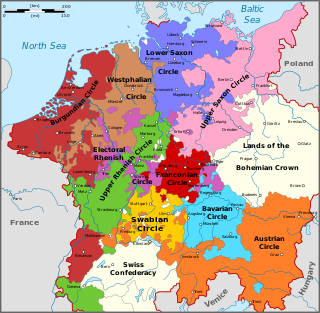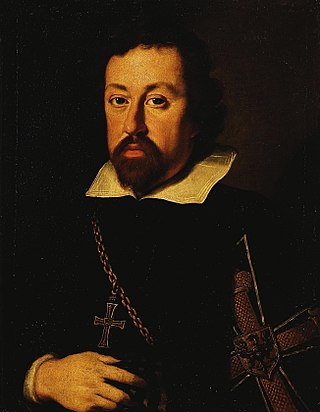
Leopold I was Holy Roman Emperor, King of Hungary, Croatia, and Bohemia. The second son of Ferdinand III, Holy Roman Emperor, by his first wife, Maria Anna of Spain, Leopold became heir apparent in 1654 by the death of his elder brother Ferdinand IV. Elected in 1658, Leopold ruled the Holy Roman Empire until his death in 1705, becoming the second longest-ruling Habsburg emperor. He was both a composer and considerable patron of music.

Ferdinand II was Holy Roman Emperor, King of Bohemia, Hungary, and Croatia from 1619 until his death in 1637. He was the son of Archduke Charles II of Inner Austria and Maria of Bavaria. His parents were devout Catholics, and, in 1590, they sent him to study at the Jesuits' college in Ingolstadt because they wanted to isolate him from the Lutheran nobles. In July that same year (1590), when Ferdinand was 12 years old, his father died, and he inherited Inner Austria–Styria, Carinthia, Carniola and smaller provinces. His cousin, the childless Rudolf II, Holy Roman Emperor, who was the head of the Habsburg family, appointed regents to administer these lands.

Ferdinand III was from 1621 Archduke of Austria, King of Hungary from 1625, King of Croatia and Bohemia from 1627 and Holy Roman Emperor from 1637 until his death in 1657.

In the Holy Roman Empire, the collective term free and imperial cities, briefly worded free imperial city, was used from the fifteenth century to denote a self-ruling city that had a certain amount of autonomy and was represented in the Imperial Diet. An imperial city held the status of Imperial immediacy, and as such, was subordinate only to the Holy Roman Emperor, as opposed to a territorial city or town which was subordinate to a territorial prince – be it an ecclesiastical lord or a secular prince.

During the early modern period, the Holy Roman Empire was divided into imperial circles, administrative groupings whose primary purposes were the organization of common defensive structure and the collection of imperial taxes. They were also used as a means of organization within the Imperial Diet and the Imperial Chamber Court. Each circle had a circle diet, although not every member of the circle diet would hold membership of the Imperial Diet as well.

Imperial Reform is the name given to repeated attempts in the 15th and 16th centuries to adapt the structure and the constitutional order of the Holy Roman Empire to the requirements of the early modern state and to give it a unified government under either the Imperial Estates or the emperor's supremacy.

German mediatisation was the major territorial restructuring that took place between 1802 and 1814 in Germany and the surrounding region by means of the mass mediatisation and secularisation of a large number of Imperial Estates. Most ecclesiastical principalities, free imperial cities, secular principalities, and other minor self-ruling entities of the Holy Roman Empire lost their independent status and were absorbed into the remaining states. By the end of the mediatisation process, the number of German states had been reduced from almost 300 to just 39.

Cambrésis is a former pagus, county and prince-bishopric of the medieval Holy Roman Empire that was annexed to the Kingdom of France in 1679. It is now regarded as one of the "natural regions" of France, and roughly equivalent to the Arrondissement of Cambrai in department Nord. The capital of Cambrésis was Cambrai. Originally ruled by a dynasty of counts, Cambrésis became a prince-bishopric in 1007, comparable to the Prince-Bishopric of Liège and the Prince-Bishopric of Utrecht. It encompassed the territory in which the bishop of Cambrai had secular authority.

Hohengeroldseck was a state of the Holy Roman Empire. It was founded by the House of Geroldseck, a German noble family which arrived in the Ortenau region of Swabia reputedly in 948, though the first mention of the family is documented in the 1080s. The family line went extinct in 1634 and was succeeded by the Kronberg and Leyen families. In 1806, the county was raised to a Principality and adopted the family name of Leyen. Late in 1813, the Principality was mediatized by Austria and its name reverted to Hohengeroldseck, but the history of the state ended when Austria ceded it to the Grand Duchy of Baden in 1819 and merged with the district of Lahr in 1831.

The Army of the Holy Roman Empire was created in 1422 and came to an end when the Holy Roman Empire was dissolved in 1806 as a result of the Napoleonic Wars.

When the Imperial Circles — comprising a regional grouping of territories of the Holy Roman Empire — were created as part of the Imperial Reform at the 1500 Diet of Augsburg, many Imperial territories remained unencircled.

Charles of Austria, nicknamed the Posthumous, a member of the Imperial House of Habsburg, was Prince-Bishop of Wrocław (Breslau) from 1608, Prince-Bishop of Brixen from 1613, and Grand Master of the Teutonic Order from 1618 until his death. In 1621 he also received the Bohemian County of Kladsko as a fief from the hands of his brother, Emperor Ferdinand II.
The Ewiger Landfriede of 1495, passed by Maximilian I, German king and emperor of the Holy Roman Empire, was the definitive and everlasting ban on the medieval right of vendetta (Fehderecht). In fact, despite being officially outlawed, feuds continued in the territory of the empire until well into the 16th century.

The Imperial Army, German: Kaiserliche Armee, Imperial Troops, or Imperials (Kaiserliche) for short, was a name used for several centuries, especially to describe soldiers recruited for the Holy Roman Emperor during the early modern period. The Imperial Army of the Emperor should not be confused with the Army of the Holy Roman Empire, which could only be deployed with the consent of the Imperial Diet. The Imperialists effectively became a standing army of troops under the Habsburg emperor from the House of Austria, which is why they were also increasingly described in the 18th century as "Austrians", although its troops were recruited not just from the Archduchy of Austria but from all over the Holy Roman Empire.

The Imperial Register was a list of the Imperial Estates of the Holy Roman Empire that specified the precise numbers of troops they had to supply to the Imperial Army and/or the financial support they had to make available to sustain the Army. An entry in the register was often viewed as an important indicator of the imperial immediacy of an imperial estate, although that was not always undisputed. The importance of the register for historical research is that all Estates were recorded in it. However, it also contains obvious errors.
The Imperial Military Constitution was the collection of military laws of the Holy Roman Empire. Like the rest of the imperial constitution, it grew out of various laws and governed the establishment of military forces within the Empire. It was the basis for the establishment of the Army of the Holy Roman Empire, which was under the supreme command of the Emperor but was distinct from his Imperial Army, as it could only be deployed by the Imperial Diet. The last Imperial Defence Order (Reichsdefensionalordnung), entitled Reichsgutachten in puncto securitatis, of 13/23 May 1681, completed the military constitution of the Holy Roman Empire.
The Circle Colonel was an office in the Imperial Circles of the Holy Roman Empire of the German Nation in the Early Modern Period.
A Reichskrieg was a war fought by the Holy Roman Empire as a whole against a common enemy. After the Peace of Westphalia in 1648, a Reichskrieg was a formal state of war that could only be declared by the Imperial Diet.

In German history, a Reichsexekution was an imperial or federal intervention against a member state, using military force if necessary. The instrument of the Reichsexekution was constitutionally available to the central governments of the Holy Roman Empire (800–1806), the German Empire of 1848–49, the German Empire of 1871–1918, the Weimar Republic (1918–33) and Nazi Germany (1933–45). Under the German Confederation (1815–66) and the North German Confederation (1867–71), the same right belonged to the confederal government and is called Bundesexekution.













